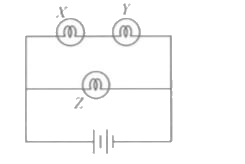Three different gases X, Y and Z of molecular masses 2, 16 and 64 were enclosed in a vessel at constant temperature till equilbrium is reaches. Which of the following statement is correct?
Gas Z will be at the top of the vessel
Gas Y will be at the top of the vessel
Gas X will be at the bottom and Z will be at the top
Gases wil form homogeneous mixture
The correct Answer is:D
To solve the question regarding the behavior of three different gases (X, Y, and Z) with molecular masses 2, 16, and 64, we can follow these steps:
Step 1: Understand the Concept of Gas Mixtures
Gases in a mixture behave independently of each other. This means that when different gases are mixed, they will not form layers based on their molecular masses. Instead, they will distribute evenly throughout the container.
Step 2: Recognize the Homogeneous Nature of Gas Mixtures
In a gas mixture, the gases will spread out to fill the entire volume of the container uniformly. This is due to the random motion of gas molecules, which leads to a homogeneous mixture regardless of their individual molecular masses.
Step 3: Analyze the Given Gases
- Gas X has a molecular mass of 2 (likely hydrogen).
- Gas Y has a molecular mass of 16 (likely oxygen).
- Gas Z has a molecular mass of 64 (likely sulfur hexafluoride).
Despite their different molecular masses, all three gases will mix uniformly in the vessel.
Step 4: Evaluate the Statements
Given the understanding of gas behavior, we can conclude that:
- No gas will be at the top or bottom of the vessel based on its molecular mass.
- All gases will be evenly distributed throughout the vessel.
Conclusion
The correct statement is that the mixture of gases (X, Y, and Z) will be a uniform homogeneous mixture.
Final Answer
The correct statement is: "The gases form a uniform homogeneous mixture."
---
Gases in a mixture behave independently of each other. This means that when different gases are mixed, they will not form layers based on their molecular masses. Instead, they will distribute evenly throughout the container.
In a gas mixture, the gases will spread out to fill the entire volume of the container uniformly. This is due to the random motion of gas molecules, which leads to a homogeneous mixture regardless of their individual molecular masses.
- Gas X has a molecular mass of 2 (likely hydrogen).
- Gas Y has a molecular mass of 16 (likely oxygen).
- Gas Z has a molecular mass of 64 (likely sulfur hexafluoride).
Given the understanding of gas behavior, we can conclude that:
- No gas will be at the top or bottom of the vessel based on its molecular mass.
- All gases will be evenly distributed throughout the vessel.
The correct statement is that the mixture of gases (X, Y, and Z) will be a uniform homogeneous mixture.
The correct statement is: "The gases form a uniform homogeneous mixture."
Similar Questions
Knowledge Check
Three different gases X, Y and Z of molecular masses 2, 16 and 64 were enclosed in a vessel at constant temperature till equilbrium is reaches. Which of the following statement is correct?
AGas Z will be at the top of the vesselBGas Y will be at the top of the vesselCGas Z will be at the bottom and X will be at the topDGases will form homogenous mixtureThree different gases X, Y and Z of molecular masses 2, 16 and 64 were enclosed in a vessel at constant temperature till equilbrium is reaches. Which of the following statement is correct?
AGas Z will be at the top of the vessel.BGas Z will be at the bottom and X will be at the top.CGas X will be at the bottom and Z will be at the top.DGases will form homogeneous mixture.Three different gases x,y,z of molecular masses 2, 16 and 64 were enclosed in a vessel at a constant temperature is correct
AGas z will be at the top of the vesselBGas y will be at the bottom and x will be at the topCGas x will be at the bottom and y will be at the topDGases will form a homogeneous mixture
For a fixed mass of gas at constant volume, which of the following statements is/are (not ) correct ?
View SolutionThe given figures show arrangement of particles of a substance X at different temperatures.

Which of the following statements is correct?
View SolutionTwo van der waal's gases have same value of a but different value of b which of the following statement is correct ?
View SolutionSohan connects three identical bulbs X, Y and Z as shown in the figure. Which of the following statements is correct?

View SolutionThe distribution of molecular speeds for CO2 at different temperatures is given below, which of the following statements is incorrect?

View Solution
